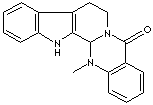|
EVODIAMINE |
| D-Evodiamine; (+)-Evodiamine; Isoevodiamine; (13bS)-14-methyl-8,13,13b,14-tetrahydroindolo[2',3':3,4]pyrido[2,1-b]quinazolin-5(7H)-one; |
|
|
| PRODUCT IDENTIFICATION |
|
|
CAS RN |
518-17-2 |
|
EINECS RN |
|
|
FORMULA |
C19H17N3O |
|
MOLE WEIGHT |
303.36 |
|
CHEMICAL FAMILY |
indole alkaloid |
| CATEGORIES | Extractives and their physically modified derivatives |
|
|
| PHYSICAL AND CHEMICAL PROPERTIES |
|
|
PHYSICAL STATE |
yellow powder |
|
MELTING POINT |
265 - 275 C |
|
BOILING POINT |
|
|
DENSITY |
|
|
SOLUBILITY IN WATER |
|
|
pH |
|
|
VAPOR DENSITY |
|
|
REFRACTIVE INDEX |
|
|
FLASH POINT |
|
|
|
| STABILITY AND REACTIVITY | |
| STABILITY | Stable under normal conditions. |
|
INCOMPATIBLE MATERIALS |
Strong oxidizing agents |
| DECOMPOSITION PRODUCTS |
Carbon oxides, Nitrogen oxides |
| POLYMERIZATION | |
|
TOXICOLOGICAL |
|
|
|
| SAFETY |
|
|
HAZARD NOTES |
Fatal if swallowed. |
|
EYE |
May cause eye irritation. |
|
SKIN |
May be harmful if absorbed through skin. May cause skin irritation. |
|
INGESTION |
Toxic if swallowed |
|
INHALATION |
May be harmful if inhaled. May cause respiratory tract irritation. |
|
TARGET ORGANS |
|
|
CHRONIC |
|
|
|
| TRANSPORT & REGULATORY INFORMATION |
|
|
UN NO. |
2811 |
| HAZARD CLASS |
6.1 |
| PACKING GROUP |
III |
| HAZARD SYMBOL |
T |
|
RISK PHRASES |
25 |
|
SAFETY PHRASES |
45 |
|
|
| EXTERNAL LINKS & GENERAL INFORMATION |
|
Wikipedia Linking: http://en.wikipedia.org/wiki/Evodiamine Evodiamine, a major alkaloidal principle of Evodia fruits (Evodia rutaecarpa, Rutaceae), showed vanilloid receptor agonistic activities comparable to capsaicin. The Chinese literature refers to Evodia fruits as a "hot nature" herb. In spite of the similarities in the actions of evodiamine and capsaicin in vitro, evodiamine has no perceptible taste, including a peppery hot taste. Therefore, the effectiveness of evodiamine and the extract of Evodia fruits in preventing obesity on male C3H mice, or male SD rats were examined. When evodiamine was supplemented at 0.03% of the diet and fed to mice for 12 days, the perirenal fat weight became significantly lower than in the control group. (http://www.ncbi.nlm.nih.gov/)Traditional Chinese herbs are regarded as a new and promising source of potential anti-cancer remedies and new chemotherapy adjuvants to enhance the efficacy of chemotherapy and/or to ameliorate its side effects. Extensive investigations have been undertaken both in the experimental and clinical studies over the years to augment the efficacy of chemotherapy. Evodia rutaecarpa is a very popular multi-purpose herb traditionally used in China for the treatment of headaches, abdominal pain, postpartum hemorrhage, dysentery and amenorrhea. The major constituents of Evodia rutaecarpa are evodiamine and rutaecarpine. Growing evidence demonstrates that evodiamine possesses anti-cancer activities both in vitro and in vivo by inhibiting proliferation, invasion and metastasis, inducing apoptosis of a variety of tumor cell lines. This review is aimed to summarize the recent researches on evodiamine focusing on anti-cancer activity and to highlight molecular mechanisms during the past ten years. (http://www.mdpi.com/ We found that evodiamine, a major alkaloidal component of Evodiae Fructus (Goshuyu in Japan), inhibited proliferation of several tumor cell lines, but had less effect on human peripheral blood mononuclear cells (PBMC). We used human cervical cancer cells, HeLa, as a model to elucidate the molecular mechanisms of evodiamine-induced tumor cell death. The results showed that evodiamine induced oligonucleosomal fragmentation of DNA in HeLa cells and increased the activity of caspase-3, but not that of caspase-1, in vitro. Both evodiamine-induced DNA fragmentation and caspase-3 activity were effectively inhibited by a caspase-3 inhibitor, z-DEVD-fmk(z-Asp-Glu-Val-Asp-fmk). In addition, evodiamine increased the expression of the apoptosis inducer Bax, but decreased the expression of the apoptosis suppressor Bcl-2 in mitochondria. Taken together, our data indicated that evodiamine alters the balance of Bcl-2 and Bax gene expression and induces apoptosis through the caspase pathway in Hela cells. (http://sciencelinks.jp/)
|
|
|
| SALES SPECIFICATION |
|
|
APPEARANCE |
yellow powder |
| ASSAY |
98.0% min |
|
MELTING POINT |
265 - 275 C |
|
HEAVY METALS |
20ppm max |
|
LOSS ON DRYING |
1.0% max |
|
|
| PACKING |
|
|
|
|
| PRICE |
|
|
